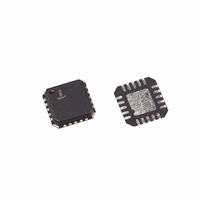ISL43240IR Intersil, ISL43240IR Datasheet - Page 9

ISL43240IR
Manufacturer Part Number
ISL43240IR
Description
IC SWITCH QUAD SPDT 20QFN
Manufacturer
Intersil
Datasheet
1.ISL43240IAZ.pdf
(14 pages)
Specifications of ISL43240IR
Function
Switch
Circuit
4 x SPDT
On-state Resistance
25 Ohm
Voltage Supply Source
Single, Dual Supply
Voltage - Supply, Single/dual (±)
±2 V ~ 6 V, 2 V ~ 12 V
Current - Supply
0.01µA
Operating Temperature
-40°C ~ 85°C
Mounting Type
Surface Mount
Package / Case
20-VFQFN Exposed Pad
Lead Free Status / RoHS Status
Contains lead / RoHS non-compliant
Available stocks
Company
Part Number
Manufacturer
Quantity
Price
Company:
Part Number:
ISL43240IR
Manufacturer:
Intersil
Quantity:
19
The low leakage current performance is unaffected by this
approach, but the switch resistance may increase, especially
at low supply voltages.
Power-Supply Considerations
The ISL43240 construction is typical of most CMOS analog
switches, in that they have three supply pins: V+, V-, and
GND. V+ and V- drive the internal CMOS switches and set
their analog voltage limits, so there are no connections
between the analog signal path and GND. Unlike switches
with a 13V maximum supply voltage, the ISL43240 15V
maximum supply voltage provides plenty of room for the
10% tolerance of 12V supplies (
as well as room for overshoot and noise spikes.
This family of switches performs equally well when operated
with bipolar or single voltage supplies. The minimum
recommended supply voltage is 2V or
note that the input signal range, switching times, and on-
resistance degrade at lower supply voltages. Refer to the
electrical specification tables and Typical Performance
curves for details.
V+ and GND power the internal logic (thus setting the digital
switching point) and level shifters. The level shifters convert
the logic levels to switched V+ and V- signals to drive the
analog switch gate terminals.
Logic-Level Thresholds
V+ and GND power the internal logic stages, so V- has no
affect on logic thresholds. This switch family is TTL
compatible (0.8V and 2.4V) over a V+ supply range of 2.5V
to 10V (see Figure 17). At 12V the V
For best results with a 12V supply, use a logic family the
provides a V
The digital input stages draw supply current whenever the
digital input voltage is not at one of the supply rails (see
Figure 18). Driving the digital input signals from GND to V+
with a fast transition time minimizes power dissipation. The
OPTIONAL
PROTECTION
RESISTOR
FIGURE 8. OVERVOLTAGE PROTECTION
OH
greater than 3V.
IN
V
NO or NC
X
9
V-
V+
±
6V or 12V single supply),
OPTIONAL PROTECTION
DIODE
OPTIONAL PROTECTION
DIODE
IH
±
level is about 2.8V.
2V. It is important to
V
COM
ISL43240
ISL43240 has been designed to minimize the supply current
whenever the digital input voltage is not driven to the supply
rails (0V to V+). For example driving the device with 3V logic
(0V to 3V) while operating with dual or single 5V supplies the
device draws only 10µA of current (see Figure 18 for
3V). Similiar devices of competitors can draw 8 times this
amount of current.
High-Frequency Performance
In 50Ω systems, signal response is reasonably flat even past
200MHz (see Figure 19). Figure 19 also illustrates that the
frequency response is very consistent over a wide V+ range,
and for varying analog signal levels.
An off switch acts like a capacitor and passes higher
frequencies with less attenuation, resulting in signal
feedthrough from a switch’s input to its output. Off Isolation
is the resistance to this feedthrough, while Crosstalk
indicates the amount of feedthrough from one switch to
another. Figure 20 details the high Off Isolation and
Crosstalk rejection provided by this switch. At 10MHz, off
isolation is about 50dB in 50Ω systems, decreasing
approximately 20dB per decade as frequency increases.
Higher load impedances decrease Off Isolation and
Crosstalk rejection due to the voltage divider action of the
switch OFF impedance and the load impedance.
Leakage Considerations
Reverse ESD protection diodes are internally connected
between each analog-signal pin and both V+ and V-. One
of these diodes conducts if any analog signal exceeds V+
or V-.
Virtually all the analog leakage current comes from the ESD
diodes to V+ or V-. Although the ESD diodes on a given
signal pin are identical and therefore fairly well balanced,
they are reverse biased differently. Each is biased by either
V+ or V- and the analog signal. This means their leakages
will vary as the signal varies. The difference in the two diode
leakages to the V+ and V- pins constitutes the analog-signal-
path leakage current. All analog leakage current flows
between each pin and one of the supply terminals, not to the
other switch terminal. This is why both sides of a given
switch can show leakage currents of the same or opposite
polarity. There is no connection between the analog signal
paths and GND.
V
IN
=












